The Surf landing trials
4 February 2025Helford and the SOE
4 February 2025This is a transcript of a report of the second exercise managed by Lt Cdr Nigel Warington Smyth RNVR to test suitable boats for landing through surf: Operation PLANIMETER 16 – 21 March 1943.1 The conclusion are similar in many respects to the SLIDERULE report but with additional theory and images.
Summary
The problem and the Investigation
Problem
2 – 3 Scope of Enquiry
4 – 10 History of Enquiry
Factors Affecting the Design of Surf Boats
11 Wave Motion
12 Conditions producing Arched Waves (Deep Water)
13 Waves on a Short Foot
14 The Critical Moment
Design of Surf Boats
15 Dimension and Proportions
16 Design of the Ends
17 General Type of Hull – Round Bilge or Hard Chine
18 Propulsion
Handling Small Boats in Surf
19 – 20 Manning
21 – 25 Surf Riding
26 – 32 Running In
33 – 34 Launching from the Beach
35 – 39 Loading
Dimensions and Capabilities of Surf Boats
CN 1, CN 3, BR 1, BR 3, PD 1, SN 1, SN 2, SN 6
Performance of Individual Boats
Specifications of Oars and Rowlocks
48 Oars
49 Optimum Internal Arrangements
49 Rowlocks
Photographs
Surf Landing
The Problem and the Investigation
Problem
To find a method of landing with small boats through surf on exposed beaches.
Scope of Enquiry
2 In general the dimensions of boats were limited by the carrying capacity of a 110-ft ML/MGB.2 The boats were required to be inconspicuous when stowed on deck while special hoisting gear was considered undesirable. To fulfil these requirements a maximum length and weight of 14ft and 3cwt were selected as suitable.
3 Larger boats have also been considered. An 18ft surf boat (CN 1) was tested and one MGB fitted to carry her. Since that time CN 1 type boats have been build in some numbers and are carried by MGBs. 22ft surf boats (CN 3) of similar design to CN 1 are also in production but their performance has not been studied. One 25ft surf boat has been tested. The lines of a 20ft surf boat (SN 6), embodying the features recommended in this report, indicate the probable optimum for carrying in a 110ft ML/MGB.
History of Enquiry
4 A preliminary investigation of literary sources and discussion with fishermen and lifeboat designers showed that no detailed information about the performance of small surf boats was available. It was the expressed opinion of the RNLI and fishermen that no boat shorter than 30, or at least 25ft could be regarded as a ‘reasonable proposition’ for surf work.
5 Messrs Camper & Nicholson carried out an independent investigation. In July 1941 they produced an 18ft hard-chine boat (CN 1), based on the lines of large West African surf boats. Apart from the fact that plywood construction imposed a series of hard chines, the lines of CN 1 were strikingly similar to the 30ft pulling lifeboat designed by the RNLI. CN 3, a 22ft version of CN 1, was later produced.
6 Neither of these boats was suitable for the work envisaged. The investigation of a 14ft surf boat was therefore continued.
7 It was known that a species of pram dinghy was used by lifeguards in surf off the Dutch beaches. One of these boats was discovered in an East coast port, but, when its measurements were taken, the midship section was found to be dangerously weak. The improvement of lines for stability involved either lengthening the boat to produce the characteristic bow or cutting off the bow in order to keep the boat to the required length. The second course was adopted, the result being a 13’ 8” boat (PD 1) of unorthodox appearance and unexpected seaworthiness.
8 Camper and Nicholson then designed a 14ft version of CN 1. Building was postponed until further information from surf trials was available and the design was finally abandoned.
9 The object of Operation SLIDERULE (7-8.8.42) was to test CN 1, PD 1 and 2 yacht dinghies. A single-ended dory (BR 1) was also provided for trial. The experience gained in Operation SLIDERULE was crystallised into two new boats of the same fundamental design – SN 1 (14ft) and SN 2 (25ft).
10 Since Operation SLIDERULE types SN 1 and PD 1 have been satisfactorily used for weight-carrying and surf-landing. On the completion of SN 2 Operation PLANIMETER was mounted (16-22.3.43) to confirm the conclusions of Operation SLIDERULE, to study in detail the performance of the new boats, to reach more definite views upon limiting conditions and to finalise details of fittings, gear and equipment. The following craft were tested: SN 1, SN 2, PD 1, BR 3, SN3, a Scotch dinghy and a collapsible Berthon boat. Several kayak-type canoes were also tested but, owing to their small carrying capacity and lack of specific surf-boat features, they are not germane to the present discussion.
Factors affecting the Design of Surf Boats
11 The movement of an unbroken wave in deep water is like the movement of a wave along a rope. Although the local motion of water particles in a wave is gently circular, the motion of the water as a whole must be regarded as vertical rather than horizontal. As the wave proceeds into shoal water it undergoes an essential transformation, the period of transition depending upon the size of the wave and the rate of shoaling of the ground. The circular motion of the water particles is disturbed and converted into a marked horizontal, forward motion. The wave is tripped at the foot, the crest advances, forming an arch higher than the initial amplitude of the wave, until finally the forward impulse of the crest carries the water beyond the support of the arch. A weight of water is then impelled downward and moves forward rapidly in the form of a smother of broken unbuoyant water.
12 The most pronounced arching is produced by a ground-swell in calm weather or with an off-shore wind. An on-shore or cross wind, whether acting upon ground swell or in forming wind-waves, tends to produce waves of comparatively smaller amplitude, causes the wave to break earlier and hurries the premature smother over the crest before a pronounced arch has formed.
13 Arching waves are most commonly encountered on a short foot whether of sand or shingle. The gradient of practically all beaches increases markedly near the high water mark. The character of the surf has therefore different characteristics at different states of tide. At and near high water the surf tends to become less extensive and in moderate conditions may be reduced to a single breaker on the beach-edge. This breaker will be found to be sudden and steep, heavy and destructive, highly-arched but confused as it breaks. This is an ugly wave both for landing and launching. The intensity of these waves is difficult to estimate from seaward, particularly as they build up suddenly almost from a calm sea, into a breaker of disproportionate size. See Figs 3 & 5.3
14 The critical moment occurs when the wave break. It is to survive that critical instant that a surf boat must be designed. The breaking wave presents two problems:
a) The downward collapse of the arch – water falling vertically into the boat and swamping it
b) The unbuoyant rapidly moving smother which follows the collapse of the arch, either swamping the boat immediately or causing it to surf-ride.
Design of Surf Boats
15 Design
a) The Overall length of the surf boat should be as great as possible but is usually limited by staff requirement.
b) Beam is governed by the carrying capacity required of the boat, by the necessity of having a good degree of stability and by general requirements of seaworthiness.
c) Draft should be kept to a minimum so that the boat retains waterborne in shallow water. The keel should be ‘rockered’ for ease of handling on the beach and to obviate the danger of grounding at speed within range of dangerous surf.
d) Freeboard and Sheer. Freeboard amidships need not be large from the point of view of seaworthiness, but it must be sufficient to enabled the boat to carry the requisite load in safety. With high freeboard, oars are less likely to be unshipped by waves, but wind resistance is increased.
Freeboard at the ends, though important, is limited severely by the need for the coxswain to clamber inboard in fairly deep water and by the undesirability of large wind resistance.
16 The design of the ends is the most important consideration.
a) The first and major problem of designing an end that will survive the collapse of an arched wave cannot be entirely solved, although the danger can be mitigated. It has been observed that, when a boat is filled by an arched wave, the water generally enters the boat in the first few feet of length. The margin of safety is greatly increased by the provision of a short deck at each end. The deck at the end which meets the oncoming seas is fitted with a high coaming; even if a boat is double-ended the same end is to seaward whether proceeding to sea or landing.
No boat will survive if placed directly under an arched wave at the instant of breaking. The water is then in vertical movement and has great kinetic energy. The survival of a boat in such waves depends almost entirely upon the judgment, quick decision and accurate timing of an experienced coxswain in preventing his boat from being engulfed.
- The second problem, of designing a boat that will not be swamped by the rapidly moving smother that follows a break, has been solved.
Early investigation showed that dinghies of normal design could not be relied upon to survive this lesser crisis. They were frequently filled or became uncontrollable in the smother, owing to their lack of sheer and reserve buoyancy in the end sections.
Prima facie the solution would appear to lie in very buoyant ends, but it was demonstrated by CN 1 that, if the buoyancy at the waterline forward is very great, the boat will rise instantly to a small wave and perpendicularly to a moderate wave. A limiting point is soon reached, where the lively vertical motion of the bows makes control extremely difficult and the stability of the crew uncertain. See Fig 2. This difficulty can most easily be surmounted by length; that is the basis of the surfmen’s assertion that 25-30 feet is the minimum length for reliable surf work.
- Buoyancy forward must be balanced by buoyancy aft. A small boat may have an excellent bow, but with small buoyancy aft will be pooped by a moderate wave when proceeding stern to sea. Further, when proceeding bow to sea a breaking wave will lift the bow and depress the stern until the boat fills and founders. This point was fully substantiated by the performance in trials both of BR 1 and normal yacht dinghies. See Fig 6.
The surf boat must be double-ended for two reasons: to provide the necessary balance of buoyancy, and to remove the dangerous necessity of turning the boat either on the edge of the breakers or on a surf-swept beach.
General type of Hull
17 The maxim of design that a hull should never surprise the water is of major importance in surf boat design. A surf boat must be smooth and gentle in her action, delicately responsive but never abrupt. In war-time plywood construction is favoured for reasons of supply, workmanship and lightness. Plywood construction imposes hard chines and hard chines involve roughness of action in varying degrees. Three different types of hard-chine plywood boats have been carefully tested. Two of these were inveterate surf-riders and, when surf-riding, invariably took an inveterate sheer. The third boat of multi-chine construction was longer (18ft) and easier in her lines. She was a good general-purpose boat, but her habit of standing on end when struck by a moderate wave caused her crew some discomfort and made her less reliable for surf-work than a boat of SN 1 type. It is concluded that any form of hard chine is undesirable and should if possible be avoided.
Propulsion
18 Propulsion
a) Oars. In respect of man-power rowing is the most economical method of propulsion. The blades of oars should be long and narrow. A long steering sweep is essential. For recommended specifications of oars and rowlocks see paras 48 and 50.
b) Paddles. A quiet but extravagant mode of propulsion. Two men in a 12ft yacht dinghy could not develop sufficient speed and manoeuvrability for surf-work. The shape of surf boats and their high freeboard compared with a canoe do not lend themselves to paddling. If a large crew is available paddling has the advantage of quickly applied power, ease of adjusting work in rough water, and absence of rowlocks. A considerable degree of co-ordination of effort is needed and the paddling attitude is relatively unstable. Paddles should be long, light in construction and full-bladed after the Canadian pattern. Admiralty pattern paddles are unsuitable.
c) Punt Poles. Punting is an effective method of getting a boat through the first critical phase of launching. Power can be quickly and positively applied. Owing, however, to the unbalanced stance adopted in punting it is essentially a matter for one man. Experience shows that the coxswain is better employed holding the boat until it is possible for him to embark. Since all gear in surf boats must be cut to a minimum it is inadvisable to carry a punt pole which will only be used for a few minutes during a launch. Although punting is not recommended for operational use, an enthusiastic surfman will find it an accomplishment which well repays the skill required to carry it out with impunity.
d) Mechanical Propulsion. A small engine may be of service in passing through unbroken water outside the surf. Extra weight and the use of precious space is involved. No form of propellor is of us in surf owing to the frequency with which the boat’s ends are clear of the water. The problem of a racing propellor is less serious with Wilson hand-propulsion gear than with an i/o engine; but in either case. The problem of water-screw revolving in air when most urgently needed is difficult to overcome. Gill-propulsion involves a considerable weight of machinery unsuitable for manhandling-boats with a small crew.
Handling Small Boats in Surf
Manning
19 The expectation of survival of a surf boat depends entirely upon the experience and training of the crew. No matter how good the design, the boat can never be fool-proof. A good surf-crew possess the qualities of instinctive watermanship, imperturbability, quick decision and well-knit team-work. In selecting and training crews every effort should be made to foster and develop these attributes. Frequent surf-work alone can familiarise crews with the infinite variety and unpredictability of surf conditions: an intimate acquaintance with surf can alone instil a profound respect for the power and weight of breaking waves. Any relaxation of vigilance or failure, through fond notions of self-styled toughness, to make due provision against injury or drowning is peremptorily punished by breaking waves.
20 The correct crew for each type of boat can only be found by practice. Ability to handle the boat on the beach determines the minimum number; the maximum is limited by the size of boat and by the quantity of stores to be carried in the particular instance. Suitable crews for the boats described are set out in para 40.
Surf-Riding
21 Surf-riding is effortless, fast and exhilarating but correspondingly dangerous. It is better suited to a summer holiday on Australian beaches than to the safe landing of a valuable cargo. A boat can most easily be made to surf-ride by pulling smartly inshore as a wave builds up astern. In heavy surf it is difficult to prevent a boat from surf-riding, while in any condition of surf a wave on the point of breaking needs little inducement to gather up a boat and carry it at speed to the beach.
22 Most boats, when surf-riding, sooner or later take a sudden sheer difficult to control. Disaster follows with inexorable certainty and swiftness. The boat is carried on the forward slope of the wave, gradually sliding back through the crest to the after slope. The sheer occurs most often while the boat is on the forward slope. The crest then crashes against the weather quarter or side and capsizes the boat in the manner of Fig 1. Throughout the critical period it is difficult for the coxswain to grip the water with the sweep and, at the speeds experienced in surf-riding, if an attempt is made to control the boat with the oars they are generally knocked out of the rowlocks.
23 When a boat is surf-riding under full control of the sweep the oars should be drawn athwartships clear of the water.
24 When a boat takes a sheer surf-riding she will roll over onto her beam ends. The action of a boat in this circumstance is very sudden. It is well that the crew take stock of the situation before abandoning ship. A boat frequently discharges her crew into the sea and rights herself without taking in much water. As a general rule the crew should hang on tight and hurl their weight to seaward against the roll. Even if a crew, through fruitless tenacity, consider that they will shortly find themselves under an upturned boat, there need be no cause for alarm provided there is a good depth of water under them.
25 Hard-chined and single-ended boats have shown themselves most likely to broach-to. Both SN 1 and SN 2 were easily controlled while surf-riding and showed no tendency to wildness.
Running In
26 A double-ended boat should be rowed in stern to sea and pulled out bow to sea. Each wave must be met squarely. A tendency to surf-ride while approaching the beach can be checked by backing down gently into each wave. Special care must be taken to avoid placing the boat under the arch of a wave.
27 In a single-ended boat the safest approach is bow to sea, except in the rare case of a boat having stronger stern sections than bow sections. Each breaker must be met squarely and the boat pulled gently to seaward through each wave to avoid surf-riding. Backing a boat on to a beach gives the coxswain little choice of landing point and is very exhausting for the crew. It has the single advantage that the sweep can readily grip the solid water as the boat passes through a breaking wave. No attempt should be made to approach stern to sea in a transom-sterned boat in other than slight surf.
In heavy surf it may be found impossible to prevent the boat form surf-riding. A small drogue should then be used, the drogue being tripped after each wave has passed. A drogue also helps to rectify any failure to meet the sea squarely. A drogue must be used with caution in a cross sea or cross wind. (see para 29 below).
29 The kedge suggests itself as a useful check in the approach and as a purchase to haul the boat off the beach. There are so few cases when a kedge can safely be used that its use must be regarded as impracticable. The current of breeze generally running along a beach leads the warp off one quarter. It is then impossible in moderate surf to keep the boat head to sea and disaster will shortly follow.
30 It is when a boat is overturned in shallow water or cast high upon a beach that the crew are in danger of suffering serious injury by being pinned between the falling boat and the ground. If it is obvious that the boat will be overturned in shallow water by a heavy wave, it is advisable that the crew abandon the boat immediately and get well clear.
31 If a boat turns beam to sea on the edge of the beach, men must not stand to leeward of her. The boat may be swept on top of them or knock them off their feet.
32 It is unwise for a crew to imagine that their boat is safe as soon as it has grounded on the beach. See Fig 4. The crew must jump out as quickly as possible to hold the boat against broaching-to; and in some circumstances it is advisable to keep one pair of oars manned at the seaward end of the boat. The boat must be hauled up clear of breaking waves, or, if loaded, as far up the beach as is practicable. Quickness in unloading the cargo is important; a heavily laden boat manned by a small crew is in a singularly vulnerable position when grounded on the edge of a beach.
Launching from the Beach
33 Before launching a surf boat all oars should be placed in their rowlocks and laid athwartships. One man must be at the bow oars and the passengers or load inboard at the earliest possible moment. The boat is then manhandled out until well afloat and under command of the oars. As convenient, successive oarsmen take their places. The coxswain is responsible for keeping the boat accurately head to sea until fully waterborne and under command.
34 The most critical launching conditions are experienced when waves are dropping dead on a short foot (see para 13 and Fig 5). The cycle of incidence of the largest waves must be studied and speedy action taken when the coxswain decides that the correct moment for launching has arrived. Owing to the steepness of these waves, the weight of falling water and the violence of the back-wash, it will be found impossible to manhandle the boat through the first breaker. The bow oarsman must be quick to pull the boat clear of danger.
Loading
35 The easy lines of SN 1, SN 2 and PD 1 make them particularly suitable for weight-carrying. Flat-bottomed dory-type boats tend to become crank when heavily laden. Reliance upon the initial stability leaves an inadequate margin of safety for surf-work.
36 In general the load carried by a boat must be reduced as the surf becomes heavier. The maximum capacities listed in para 40 allow 10 inches to 1ft minimum freeboard. Boats should be loaded to this capacity only when slight surf is expected. Each boat should be studied by her operational crew and principles of representative loads laid down for various degrees of surf as a result of experience. So many variable factors operate in producing particular amplitudes, speeds, weights and breaking characteristics of surf waves that no precise a priori criteria of surf intensity are possible. Coxswains and Commanding Officers should take every opportunity of studying wave formation and the effect upon surf of wind, tide, beach-gradient and nature of the ground, so that familiarity and experience can shape the reliability of estimates which will, in the last analysis, always be subjective.
37 Similarly the distribution of weight in individual boats must be studied by coxswains and Cos. In surf boats of SN 1 – SN 2 type weight can be fairly evenly distributed throughout the boat, care being taken that the liveliness of the ends is not impaired. The less top buoyancy there is in the ends of other boats, the more the weight must be disposed amidships. Violent vertical motion in surf will result but this is preferable to the sluggishness of response of over-laden ends.
38 It is assumed that the weight-carrying problem is almost exclusively one of landing rather than embarking. If a load is to be carried away from a beach, particular care must be exercised in stowing. When a considerable proportion of the weight is disposed forward of midships a boat has little chance o surviving the first heavy breakers on a short foot.
39 In view of the motion of surf boats, loads must be carefully secured against shifting; otherwise personnel will be injured or the boat stove in. The load should consists of small units, preferably not heavier than 50lbs and of small positive buoyancy. Unless the loaded boat can be hauled well clear of the surf, unloading is an operation requiring nimbleness and well co-ordinated team-work.
5 Capacities and Dimensions of Surf Boats
| Para 40 | CN 1 | CN 3 | BR 1 | BR 3 | PD 1 | SN 1 | SN 2 | SN 6 |
| Type | West African | West African | Dory | Dory | Dutch pram modified | New Design | New Design | New Design |
| Construction | Plywood – multiple hard chine | Plywood – multiple hard chine | Plywood – single hard chine | Plywood – single hard chine | Clench | Clench | Carvel Double diagonal | Carvel Double diagonal |
| Length overall | 18’ 0” | 22’ 0” | 13’ 7” | 14’ 2” | 13’ 6” | 14’ 3” | 24’ 9½” | 20’ 0” |
| Beam | 5’8” | 6’ 0” | 5’ 0” | 5’ 0” | 5’ 2” | 5’ 0” | 6’ 0½” | 5’ 4” |
| Depth | 2’ 4½” | 2’ 8½” | 1’ 4” | 1’ 4” | 2’ 1” | 2’ 0” | 2’ 4” | 2’ 2” |
| Weight | 4½ cwt | ? 9 cwt | – | – | 280 lbs | 3 cwt | ? 7 cwt | ? 6 cwt |
| Maximum capacity | 1 ton + 5 men | 2 tons | – | – | 12 ton + 4 men | ½ ton + 3 men | 3 tons | 1.9 tons (estimate) |
| Crew | Coxswain + 2 men + 4 men | ? Coxswain + 4 men | – | – | Coxswain + 1 man + 2 men | Coxswain + 1 man + 2 men | Coxswain + 6 men | Coxswain + 4 men |
Performance of Individual Boats
Yacht and Service Dinghies
41 Several transom-sterned dinghies and one Scottish dinghy have been tested in surf from time to time. Their lack of flare and freeboard forward makes them incapable of surviving heavy smother, while their single-endedness is an inherent weakness. SN 3, a 10’ 9” French type dinghy with very buoyant but unflared bow and full tumble-home stern, gave a good performance when carefully handled bow to sea. It can be assumed, however, that the life of such dinghies will be short and precarious even in modest roll-waves.
CN 1
42 This boat has been tested almost to the limit but was never capsized or filled. In the last launching, on the evening of 9.8.42, she was several times thrown into the vertical (see Fig 2, taken before she had reached the top of her swing). This is the boat’s only weakness; for, although dry and buoyant, her lift was too quick, with the result that she became ‘uninhabitable’ before her other qualities were tested to the limit. It is noteworthy that the buoyancy astern was sufficient to prevent her filling in the vertical position, and that her recovery was positive without being unduly abrupt. No boat of this design was available for trial in Operation PLANIMETER. Comparison with SN 1 and SN 2 cannot therefore be precise. It is considered that SN 1 and SN 2 survived surf of greater intensity than was experienced in Operation SLIDERULE.
PD 1
43 See Fig 8. On paper this boat looks too bluff for pulling through a heavy sea. It was thought that a breaking sea, striking the flat surface of the upper bow, would stop her dead. In Operation SLIDERULE it was observed that her head lifted so quickly to a wave that she was not in fact stopped. In respect of buoyancy her ends are well balanced and she has never shown any sign of being filled aft by the lifting of her bow. The conclusion was reached in Operation SLIDERULE that she could safely negotiate as heavy surf as CN 1, carrying, in moderate surf, as many as 5 men. The heavier conditions of Operation PLANIMETER revealed that, although she is an excellent weight-carrier, she has certain limitations in surf. Her most serious defect is that she is single-ended. She can only be safely landed bow to sea; for it was found that waves falling against her broad transom forced her across the sea without protection against the next wave. As has already been remarked the manoeuvrability of a boat and choice of landing place are limited when she has to be backed in to the beach. When loaded no great weight should be placed in her bow. With these qualifications she had proved to be a thoroughly reliable boat for surf-landing and weight-carrying.
BR 1
44 No lines of this boat are available but her features are clearly shown in Fig 6. Her bow was lively and dry but the boat is rendered useless for surf-work by her low unbuoyant stern. On several occasions she was pooped by a following sea, or filled by having her stern depressed by a head-on wave. In surf-riding she invariably took a wild sheer, due possibly to her hard single chine. When loaded with more than 3 men she became unstable and clumsy to row.
BR 3
45 See Fig 7. Modified from BR 1, with increased freeboard and flare aft, this boat is a marked improvement on her prototype but is an unsatisfactory surf-boat. Her low skeg aft makes it advisable to land stern to sea to avoid grounding. When manned by a crew of 2 she was an incorrigible surf-rider and once surf-riding takes a wild sheer. With a crew of 4 she behaved more rationally but her flat surfaces invite surf-riding, while her flat bottom makes her crank when laden.
SN 1
46 See Fig 9. This new design, evolved from the conclusions of Operation SLIDERULE, has fulfilled all expectations and is, as a type, the solution to the problem of surf-landing. Her ample top buoyancy and the planning surfaces at the ends allow her to survive broken water and shows no tendency to fill by the stern when lifted to a steep angle. When she surf-rides she is responsive to the sweep and shows no signs of wildness. She has only once been capsized; when she was intentionally placed under the arch of a big wave. The wave breaking into her instantly filled her. This is her limiting condition. A short deck is to be fitted fore and aft.
SN 2
47 See Figs 10 – 12. The basic design of SN 1, incorporated in a 25ft boat, has produced a boat of similar performance. Quick and dry in broken water, her smooth action helps her to surmount considerable waves without inconvenience to her crew. Limiting weather conditions or this boat have not yet been experienced in trials, but she has been found easy to row to seaward and easy to control when surf-riding. Short decks have been fitted fore and aft. Large capacity gravity bailers of RNLI pattern should be fitted to overcome the difficulty of emptying such a heavy boat if filled with water.
Specifications of Oars and Rowlocks
48 Oars
| Length overall | End of handle to inner edge of leather | Width of leather | Length of blade | |
| SN 2 | 11’ 0” | 2’ 5½” | 1’ 0” | 3’ 6” |
| SN 6 | 9’ 6” | 1’ 11” | 1’ 0” | 3’ 2” |
| SN 1 PD 1 | 8’ 6” | 2’ 0” | 1’ 0” | 3’ 0” |
The blades of all oars should be long, narrow and tapered.
49 Optimum Internal Arrangements
| Distance between Thwarts, centre to centre | 3’ 3” |
| Centre of Thwart to Rowlock position | 1’ 4” |
| Seat below gunwale | 8” |
| Seat width | 8” or 9” |
50 Rowlocks
Detailed drawing for rowlocks suitable for surf work is attached.
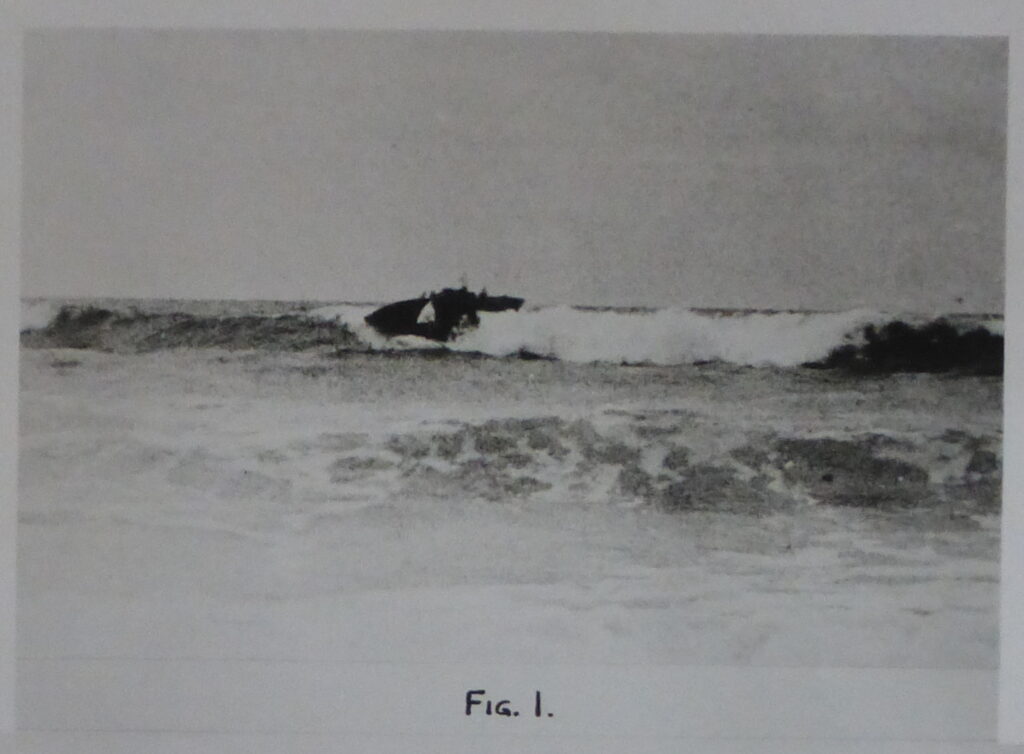
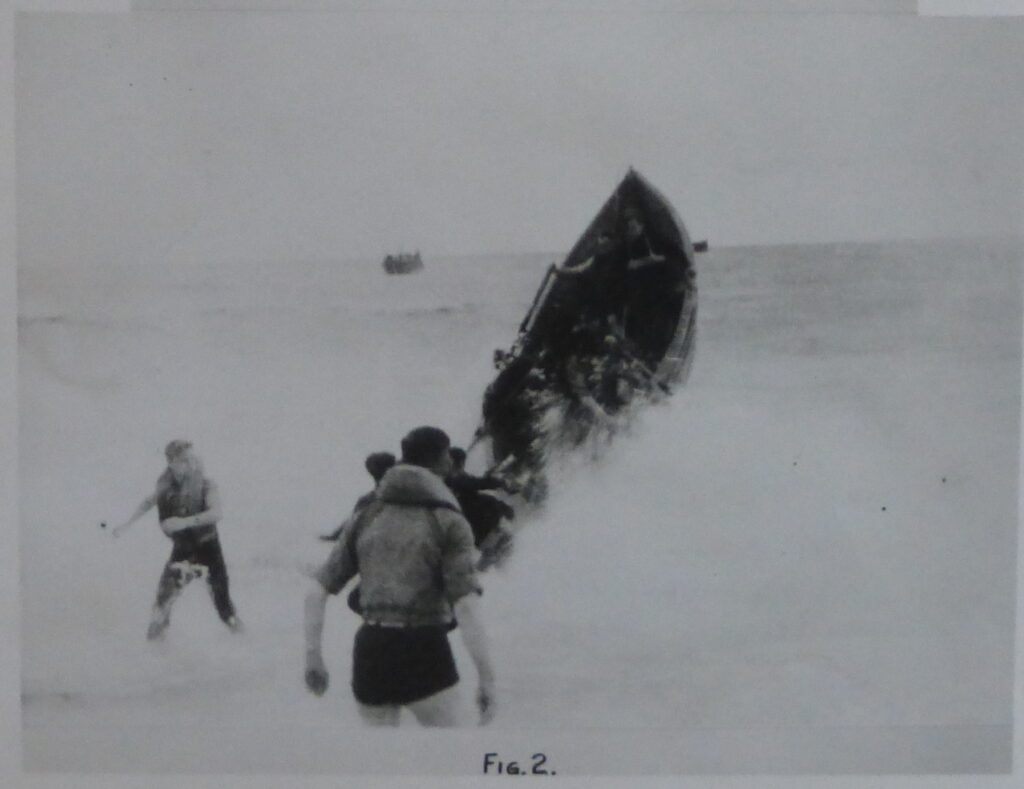
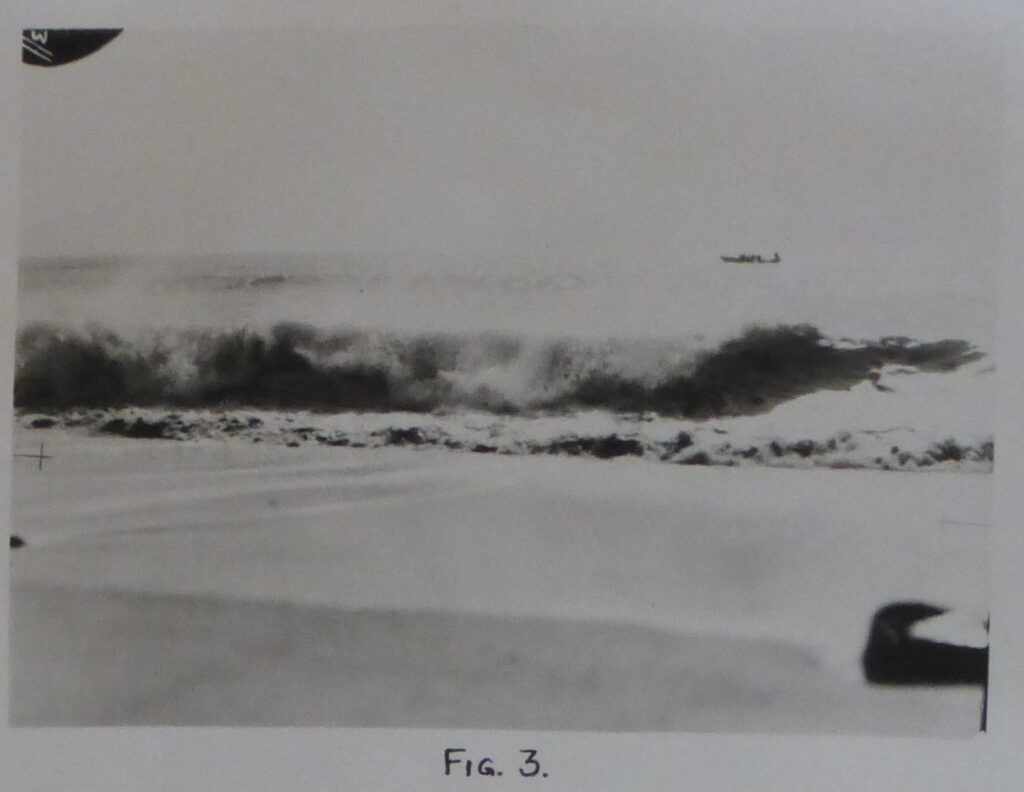
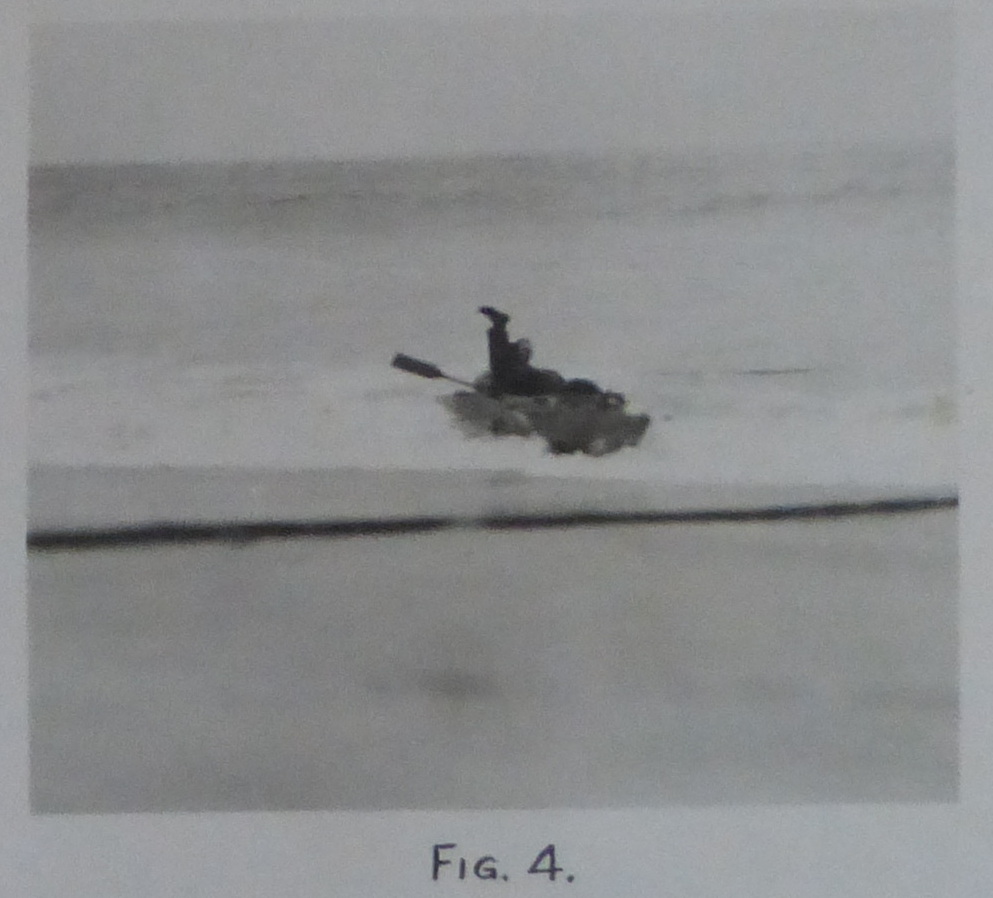
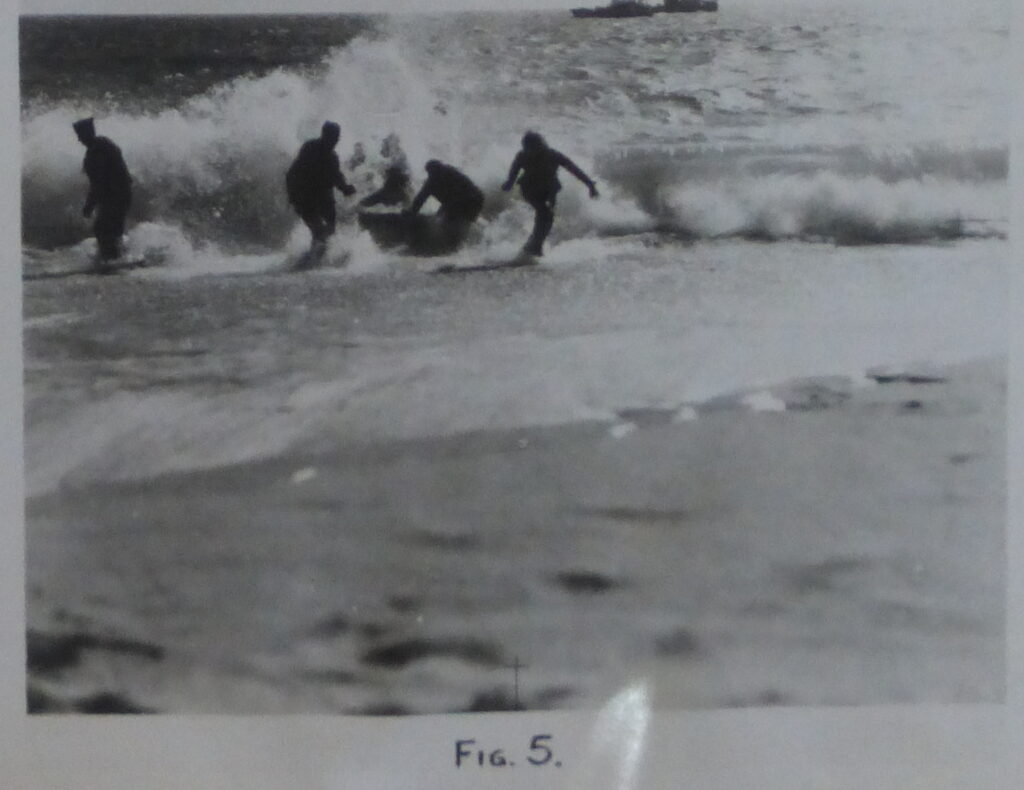
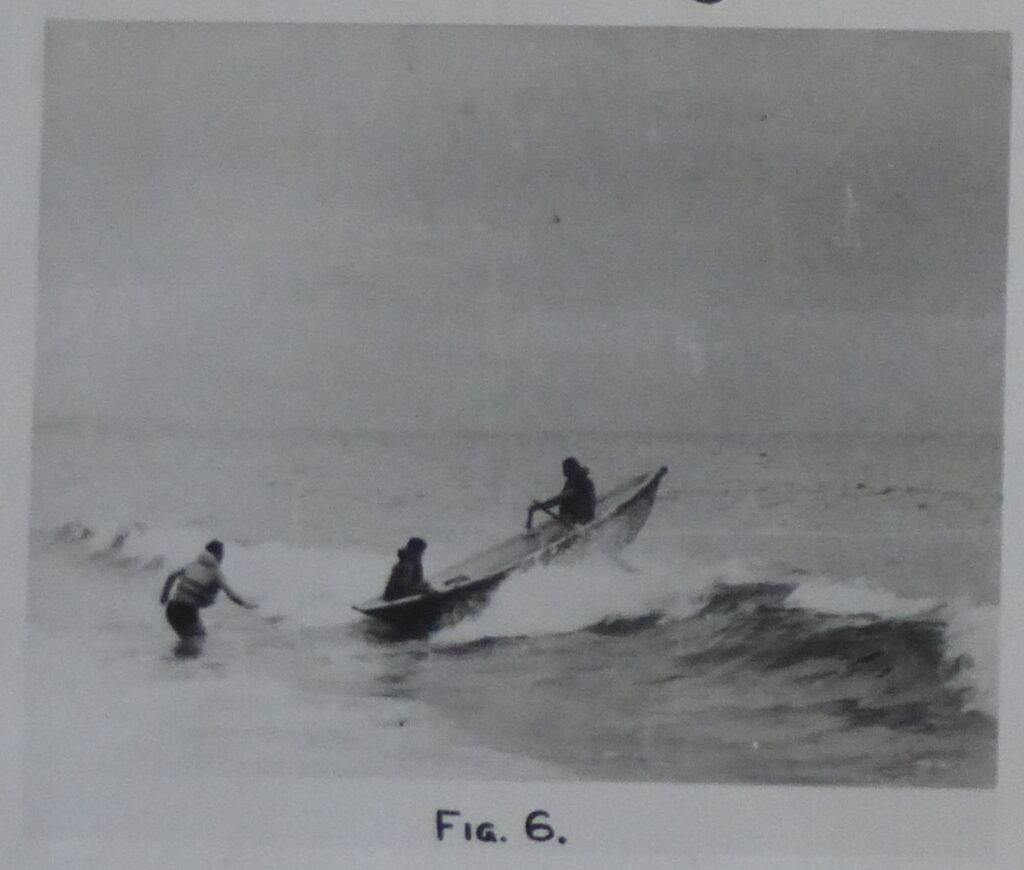
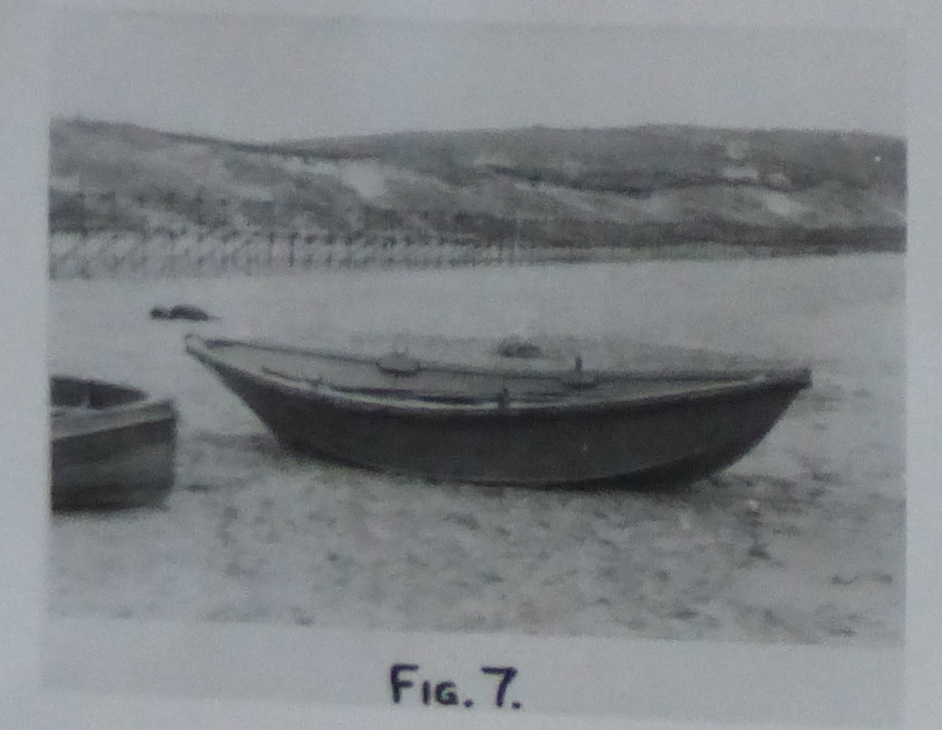
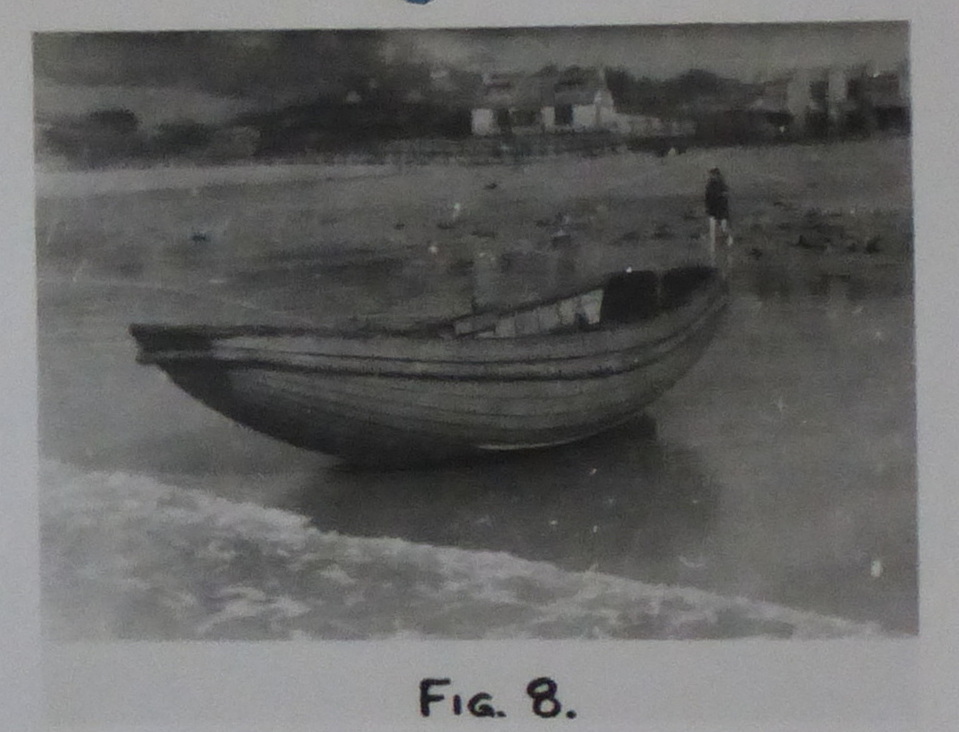
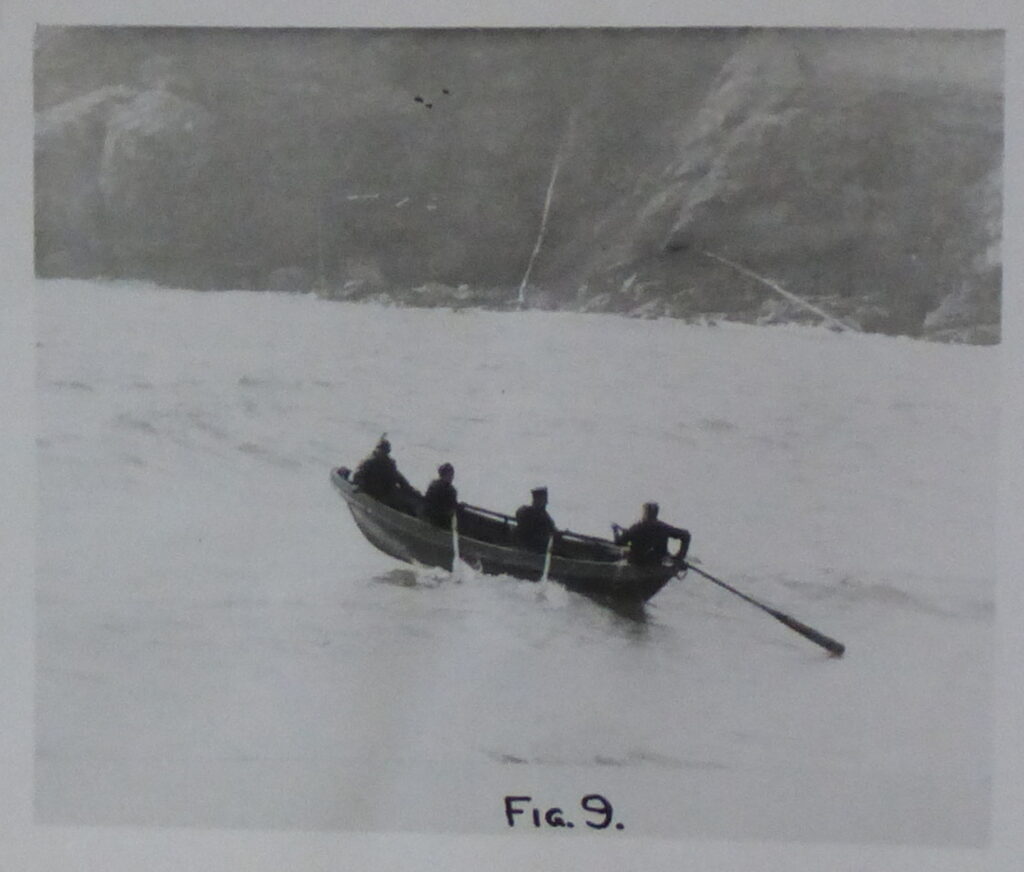
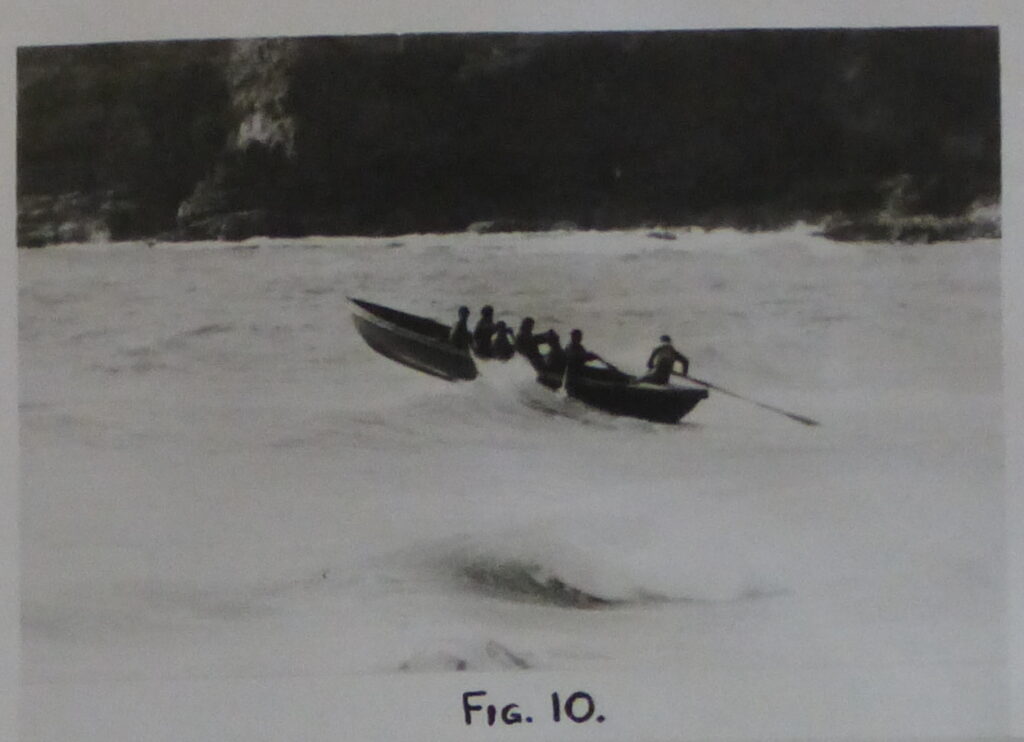
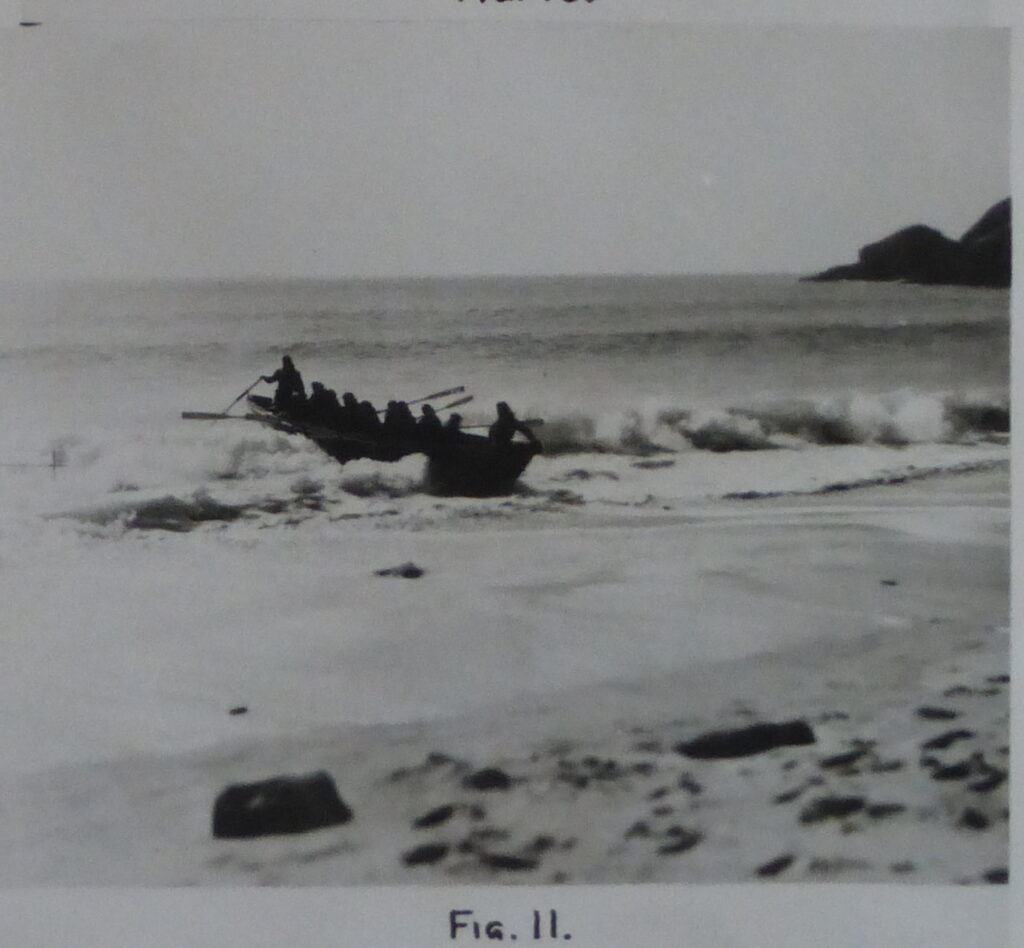
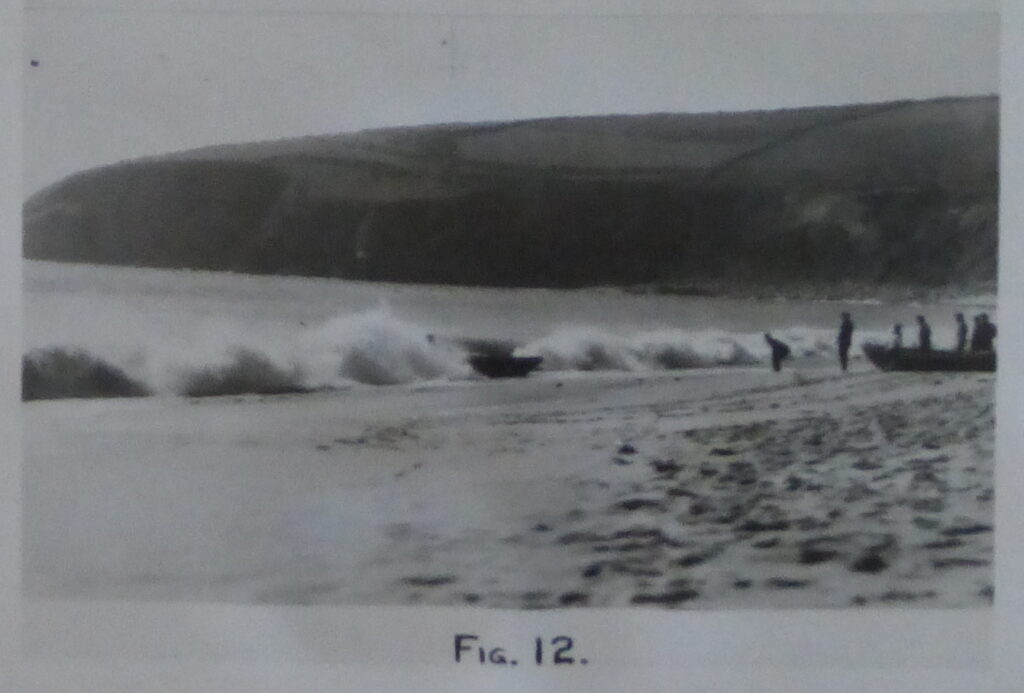
There is an associated document in another file at the National Archives.4 This was probably written by Lt Cdr Luard who was the Inshore Patrol Flotilla liaison officer at RAF St Eval.
Notes on Surf Boats
After watching Planimeter I felt that it was quite obvious that length is one of the essential in surf boats, the performance of SN 2, owing to her extra length, being superior to that of SN 1, PD 1, and BR 3. The last boat showed a distinct tendency to plane on the wave crests – fatal if this happens too far inshore.
The performance of SN 2 seemed almost perfect, but it struck me that she might be slightly improved were she given slightly less buoyancy at the ends and a slightly longer bottom so that when running up the beach her forefoot would not touch quite so soon, thus giving her more chance of running farther up before a breaker threatened to swamp the boat.
It seems that in a boat of this size, some means of emptying her rapidly is essential, as when she was swamped on Thursday she became so heavy that it took about 15 men to haul her up foot by foot and turn her over to clear her of water. Either powerful Vortex pumps or others of similar high capacity might be one solution. Alternatively, it should be possible to embody non-return sluice valves in her bottom planking.
It seems to me that it would be well worthwhile building a much narrower and longer boat, which would be constructed of plywood with watertight bulkheads fore and aft, and suitable sliding covers, for a crew of, say, 4. It might be possible to build a boat of this type – rather on the lines of an enlarged canoe – which would weigh approximately 250 lbs, and section her for stowage purposes as in our A/C catamaran dinghies, so that the 2 middle sections are 8 ft long and the 2 end sections 7 ft long or alternatively the middle section being 15 ft long, with two 7 ft end sections. This boat would be much more inclined to cut through the breakers when being launched, and if properly handled when running inshore, to let breaking waves past her. She would be worked by paddles and not oars, and should be capable of carrying between ¾ ton and a ton of stores. It should not be necessary to give her any additional stability by means of outrigger, folding or otherwise; but if these should prove necessary a blister below the gunwale might be a solution worth trying.
RAF Section
St Eval
21.3.43
